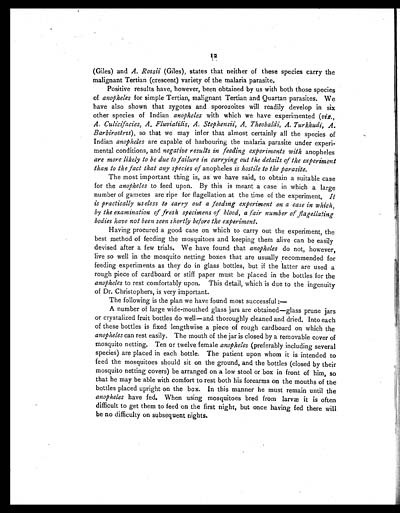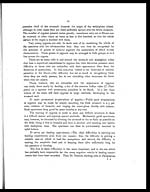Medicine - Institutions > Army health reports and medical documents > Scientific memoirs by officers of the Medical and Sanitary Departments of the Government of India > Number 2 - Malaria in India > Part I > Methods of investigation
(20) Page 12
Download files
Individual page:
Thumbnail gallery: Grid view | List view

12
(Giles) and A. Rossii (Giles), states that neither of these species carry the
malignant Tertian (crescent) variety of the malaria parasite.
Positive results have, however, been obtained by us with both those species
of anopheles for simple Tertian, malignant Tertian and Quartan parasites. We
have also shown that zygotes and sporozoites will readily develop in six
other species of Indian anopheles with which we have experimented (viz.,
A. Culicifacies, A. Fluviatilis, A. Stephensii, A. Theobaldi, A. Turkhudi, A.
Barbirostris), so that we may infer that almost certainly all the species of
Indian anopheles are capable of harbouring the malaria parasite under experi-
mental conditions, and negative results in feeding experiments with anopheles
are more likely to be due to failure in carrying out the details of the experiment
than to the fact that any species of anopheles is hostile to the parasite.
The most important thing is, as we have said, to obtain a suitable case
for the anopheles to feed upon. By this is meant a case in which a large
number of gametes are ripe for flagellation at the time of the experiment. It
is practically useless to carry out a feeding experiment on a case in which,
by the examination of fresh specimens of blood, a fair number of flagellating
bodies have not been seen shortly before the experiment.
Having procured a good case on which to carry out the experiment, the
best method of feeding the mosquitoes and keeping them alive can be easily
devised after a few trials. We have found that anopheles do not, however,
live so well in the mosquito netting boxes that are usually recommended for
feeding experiments as they do in glass bottles, but if the latter are used a
rough piece of cardboard or stiff paper must be placed in the bottles for the
anopheles to rest comfortably upon. This detail, which is due to the ingenuity
of Dr. Christophers, is very important.
The following is the plan we have found most successful :—
A number of large wide-mouthed glass jars are obtained—glass prune jars
or crystalized fruit bottles do well—and thoroughly cleaned and dried. Into each
of these bottles is fixed lengthwise a piece of rough cardboard on which the
anopheles can rest easily. The mouth of the jar is closed by a removable cover of
mosquito netting. Ten or twelve female anopheles (preferably including several
species) are placed in each bottle. The patient upon whom it is intended to
feed the mosquitoes should sit on the ground, and the bottles (closed by their
mosquito netting covers) be arranged on a low stool or box in front of him, so
that he may be able with comfort to rest both his forearms on the mouths of the
bottles placed upright on the box. In this manner he must remain until the
anopheles have fed. When using mosquitoes bred from larvæ it is often
difficult to get them to feed on the first night, but once having fed there will
be no difficulty on subsequent nights.
Set display mode to: Large image | Zoom image | Transcription
Images and transcriptions on this page, including medium image downloads, may be used under the Creative Commons Attribution 4.0 International Licence unless otherwise stated. ![]()
| Permanent URL | https://digital.nls.uk/75022406 |
|---|
| Shelfmark | IP/QB.10 |
|---|---|
| Additional NLS resources: | |




